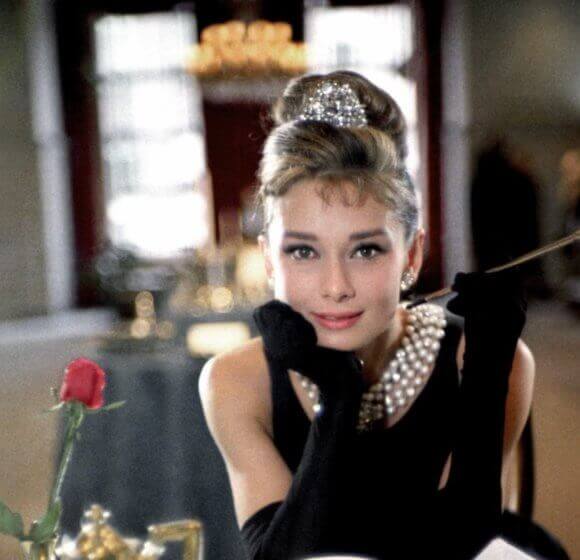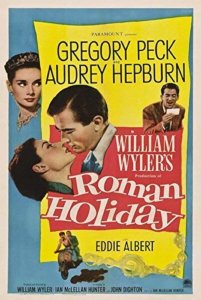There has never been another star as elegant and graceful as Audrey Hepburn. We lost her at far too young an age, and the cinema world is a lesser place.
Hepburn embodied everything the word ‘lady’ exemplified. She was fashionably thin before it became the rage. She had a swan-like neck that was the perfect setting for Tiffany necklaces. Her girlish body was the perfect setting to drape the finest clothes designed by Paramount Studio’s Edith Head or her favorite French designer Hubert de Givenchy. She was style, she was charm, she was timeless beauty.
Her life was not always spotlights and limousines. Born in Brussels in 1929 to a Dutch Baroness mother and an Anglo-Irish businessman father, she grew up in Holland during World War II. She, along with millions of others in Europe at that time, suffered deprivations and near starvation. Despite the hardships, she dreamed of becoming a ballerina and studied dancing after going to London. At age 19 she was a chorus girl in the musical “High Button Shoes.” The ballet didn’t work out, but another avenue of fame was looming on the horizon.
She was signed as a starlet by Associated British Films and played bit parts in eight films. While shooting Monte Carlo Baby on location, she was spotted by French author and playwright, Colette. Hepburn, at 22, was considered ‘perfect’ for the lead role in the Broadway production of the play Gigi by Colette.
Before she left for New York and overnight fame, Hepburn was given a screen test by Paramount that was seen by director William Wyler. He wanted her for the role of the Princess in Roman Holiday (1953) when actress Jean Simmons dropped out. Hepburn co-starred with La Jolla-born Gregory Peck. She won the Best Actress Oscar at age 24 for her first starring role. She was now a “movie star” after a meteoric overnight success.
When director Billy Wilder saw her, he said, “She’s a wispy, thin little thing, but you’re really in the presence of somebody when you see that girl.” As did everybody, Wilder fell in love with her and cast her in Sabrina with William Holden and Humphrey Bogart in 1954. She then continued at the peak of her stardom by appearing in a series of hit films such as War and Peace (1956) with Henry Fonda, the musical Funny Face (1956) with Fred Astaire, the romantic comedy Love in the Afternoon (1957) with Gary Cooper, The Nun’s Story (1958) with Oscar-winning actor Peter Finch (Network), Green Mansions (1958) with actor Anthony Perkins and directed by her husband Mel Ferrer, and The Unforgiven (1959) with Burt Lancaster.
Most stars have a signature film for which they are most remembered. Although Hepburn counted Funny Face and The Nun’s Story as her own favorites, the public took her to heart in the tremendous hit Breakfast at Tiffany’s (1961) with George Peppard. Author Truman Capote originally wanted Marilyn Monroe for the role of Holly Golightly, but Hepburn made the part her own. She is often shown today in photos wearing the signature black dress and holding the long cigarette holder that became her trademark.
Romance wasn’t neglected and she married actor/director and La Jolla Playhouse founder Mel Ferrer in 1954 and gave birth to her son, Sean. She and Ferrer divorced in 1968.
The actress didn’t shy away from a serious lesbian role in The Children’s Hour (1962) with Shirley MacLaine, but she bounced right back with the delightful comedy Charade (1963) with dapper Cary Grant. Another attempt at comedy, Paris When It Sizzles, fizzled in ’64.
By 1969 her career was waning when she married Italian psychiatrist Dr. Andrea Dotti. Moving to Rome, she and Dotti produced their son, Luca. Choosing motherhood and marriage over film stardom, she slowed down her participation in films. She occasionally returned to star in such films as Robin and Marion (1976) with Sean Connery and Bloodline (1979) with Omar Sharif. She divorced Dotti in 1980 and moved on to new interests.
She became involved with UNICEF and traveled the world with her new companion, Robert Wolders, to help Third World children struck with starvation and AIDS. In 1992 she was awarded the Presidential Medal of Freedom. She was devoted to her new role in life and gave tirelessly of herself until she became stricken with colon cancer. She died January 20, 1993 at age 64 at her home in Switzerland. Her two sons, Sean and Luca, have set up the Audrey Hepburn Children’s Fund to help suffering children around the world.








